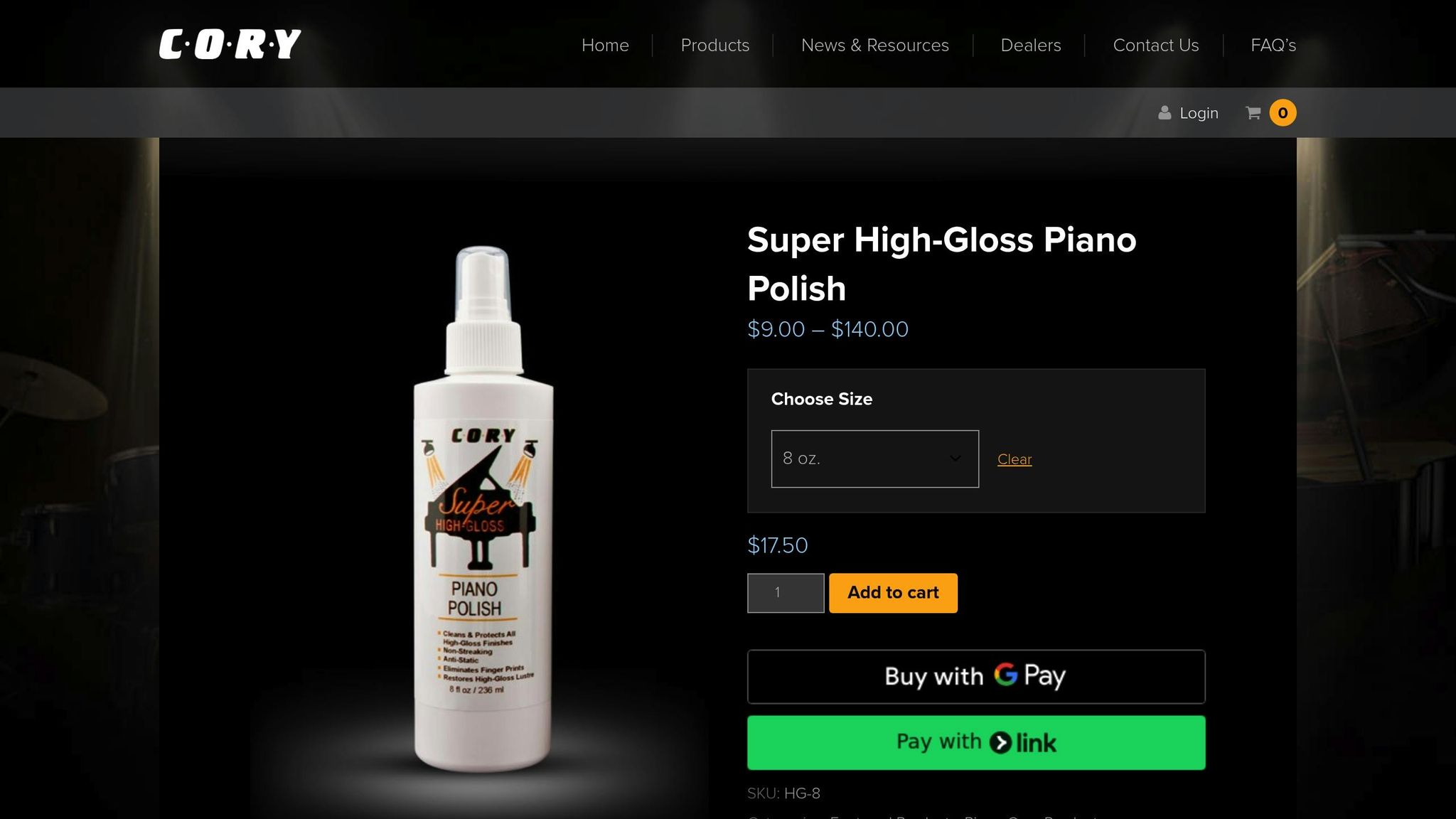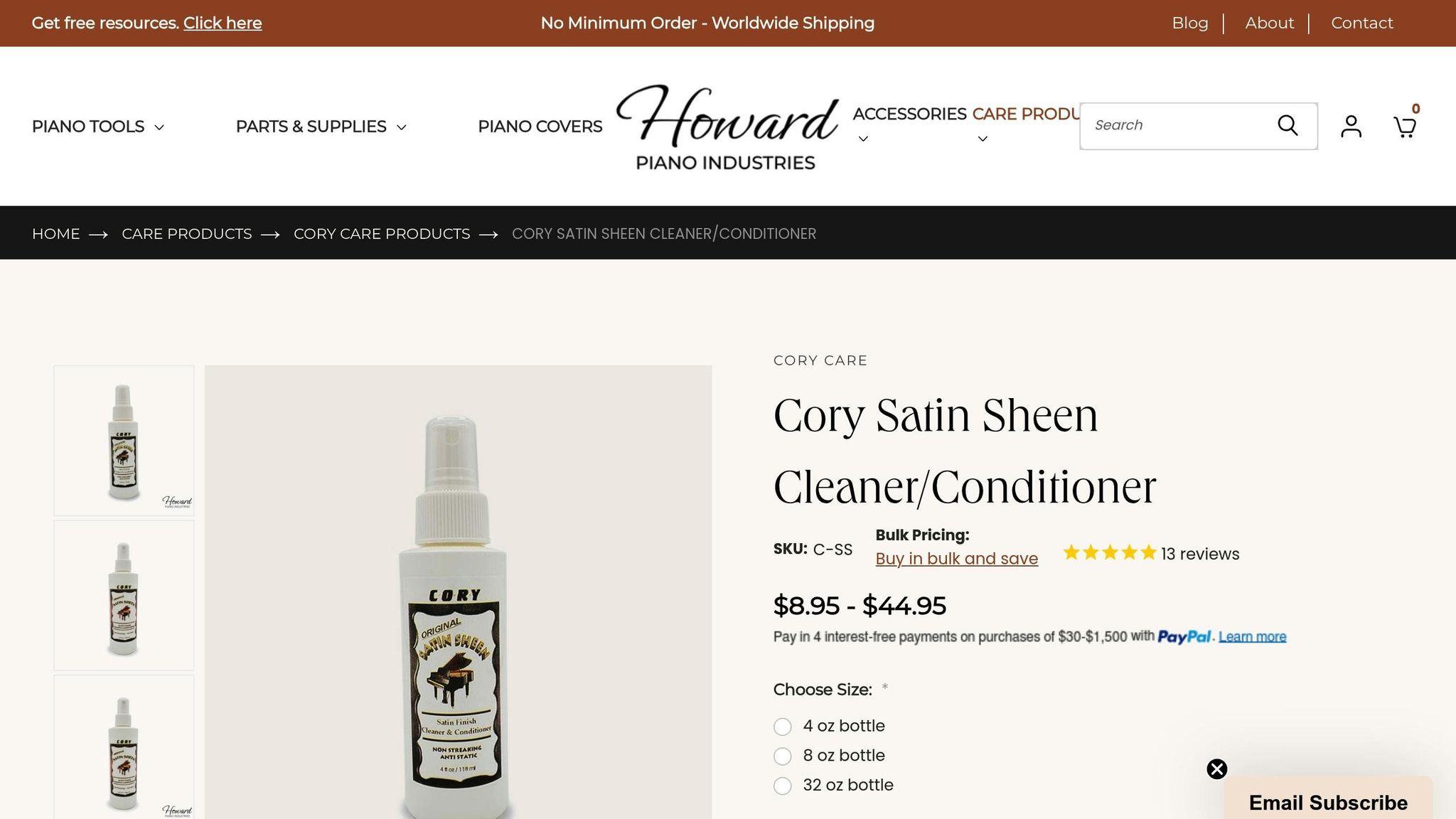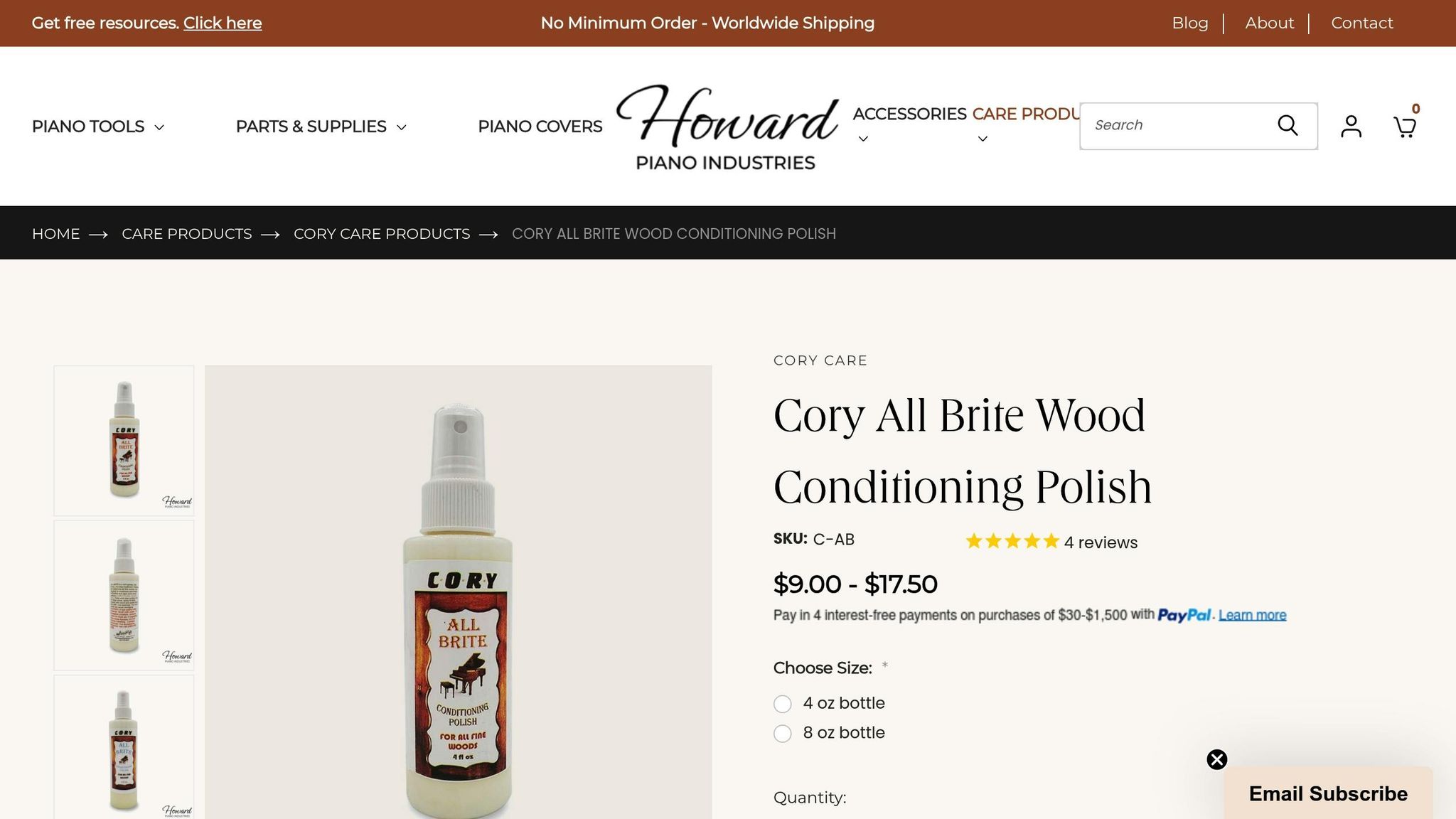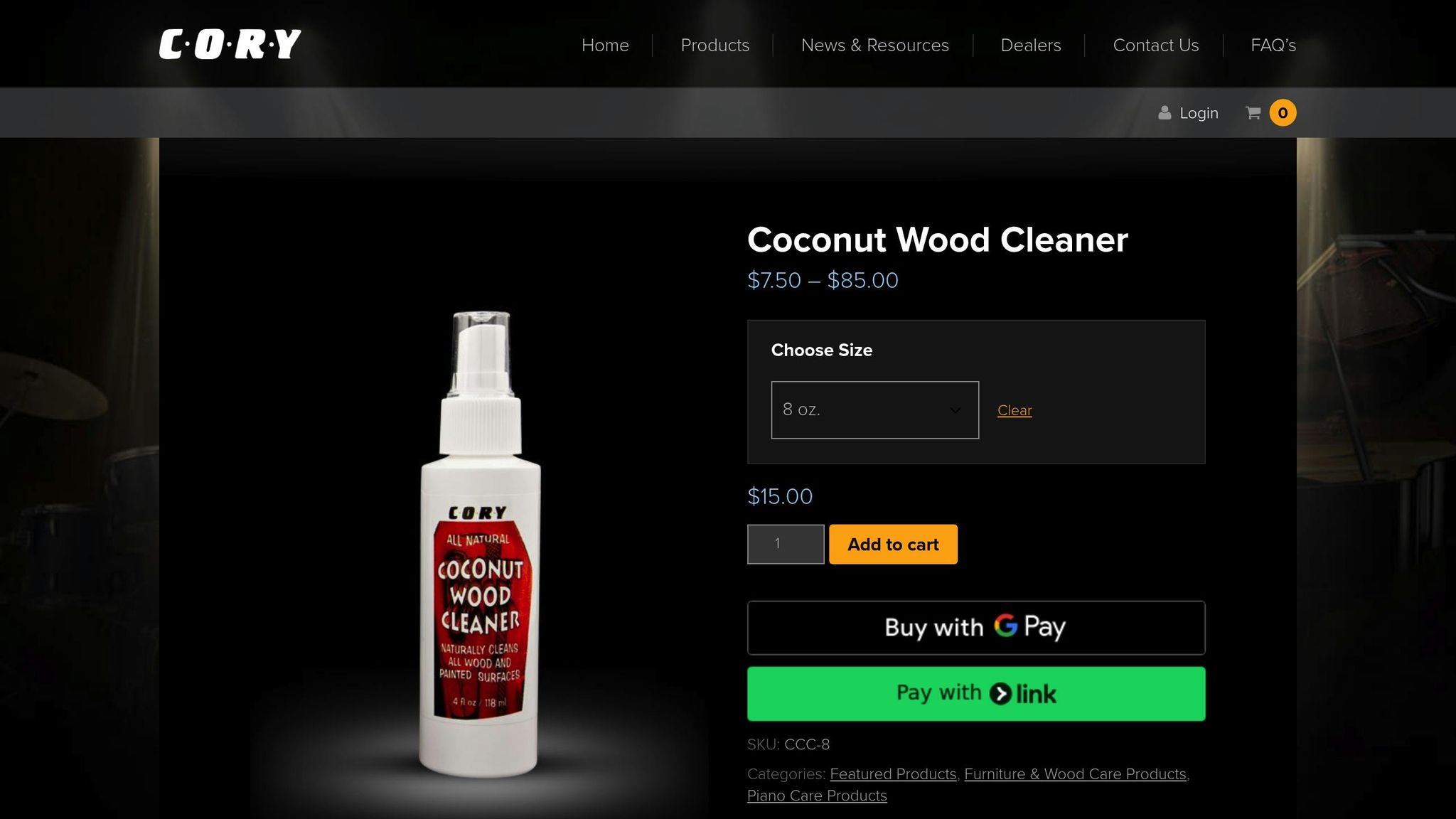When it comes to keeping your piano’s wood finish in top condition, choosing the right cleaning and polishing products is essential. Pianos typically feature lacquer or polyester finishes, each requiring specific care. Using the wrong products or techniques can lead to scratches, dullness, or even permanent damage. This guide highlights the best cleaning products, proper maintenance methods, and when to seek professional help.
Key Takeaways:
- Finish Types: Lacquer (common in older or American pianos) and polyester (modern, durable but harder to repair).
- Top Products:
- Cory High Gloss Polish: For high-gloss finishes.
- Cory Satin Sheen Cleaner: Maintains satin and open-pore finishes.
- Cory All-Brite Wood Conditioner: Hydrates and protects natural wood.
- Cory Pre-Polish Cleaner: Prepares surfaces by removing residue.
- Cory Coconut Wood Cleaner: Deep cleans tough grime.
- Cleaning Tools: Use microfiber cloths; avoid paper towels, feather dusters, or household cleaners.
- Routine: Dust daily, clean weekly, polish monthly. Avoid over-polishing to prevent buildup.
For stubborn residue or damage, professional services can restore your piano’s finish and value. Regular care combined with expert maintenance ensures your piano remains a stunning centerpiece for years.
Polishing your Piano, How-to
Piano Wood Finish Types
Knowing your piano’s finish is key to selecting the right cleaning and polishing products that protect its surface and maintain its beauty.
Types of Piano Finishes
Pianos typically come with lacquer or polyester finishes, each with unique characteristics. Most American-made pianos use lacquer, while polyester is common in Asian and European models [1]. These finishes not only affect the instrument’s appearance but also its care and maintenance.
Lacquer finishes have been around since the 1920s and are still used on premium pianos today [3]. When applied in a high-gloss style, lacquer creates a striking visual depth that’s hard to replicate with modern materials [3]. However, lacquer is softer, making it more susceptible to scratches. On the upside, minor damage can be repaired relatively easily [3].
Polyester finishes, introduced in the 1950s, are now the standard for most modern pianos [3]. Known for their hard, thick, and reflective surface, polyester finishes resist scratches better than lacquer. However, their brittleness can lead to cracking, and repairs often involve removing damaged sections, which can be more challenging [6].
Piano finishes also differ in sheen levels:
- High-gloss finishes: These create a mirror-like surface but tend to highlight dust and fingerprints.
- Satin finishes: Offer a soft, non-reflective look.
- Open pore finishes: Showcase the natural wood grain, adding texture and character [2][4][7].
The wood species used in a piano – like cherry, mahogany, walnut, oak, or beech – also plays a role. Each type of wood affects the piano’s durability and how blemishes appear, influencing how the finish should be maintained [2][4].
Color finishes add another layer of consideration. Black is a popular choice for performance pianos due to stage lighting but easily shows dust. White finishes brighten spaces but are more prone to sun damage and grime buildup [2][4][5].
Understanding these details helps you choose the right cleaning and polishing methods for your piano.
How to Identify Your Piano’s Finish
Identifying your piano’s finish ensures you use the proper cleaning products and techniques. While the finish doesn’t impact sound quality, it greatly influences the instrument’s appearance and care needs [2][4].
The most reliable way to determine the finish is by consulting the owner’s manual or a professional technician. However, you can also identify it visually or by touch:
- Visual inspection: High-gloss finishes are shiny and mirror-like, satin finishes have a muted sheen, and open pore finishes reveal the wood grain.
- Touch test: Polyester feels harder and thicker, especially around edges where it creates a rounded texture [6]. Lacquer, on the other hand, feels thinner and may show more wear at corners and edges [1].
The piano’s age and origin can provide additional clues. American-made pianos are more likely to have lacquer finishes, while Asian and European models often feature polyester. Instruments made before the 1950s usually have lacquer finishes, whereas newer ones may use either type [1].
Once you’ve identified the finish, select cleaning products accordingly:
- For satin finishes, avoid gloss-enhancing cleaners that could alter their matte look [1][3].
- High-gloss finishes require products that preserve their reflective quality without causing damage.
Always avoid household cleaners on piano finishes. Instead, use a soft microfiber cloth and spray the cleaner onto the cloth – not directly onto the piano. This prevents moisture from seeping into joints, which could harm the finish [3][7].
Properly identifying your piano’s finish is the first step to maintaining its beauty and longevity.
Top Piano Wood Polishing Products
When it comes to keeping your piano looking its best, choosing the right product for its specific finish is key. The Cory brand stands out for its range of products designed specifically for piano finishes, offering options that cater to high-gloss, satin, and natural wood finishes.
Cory High Gloss Polish
If your piano has a polyester or polyurethane high-gloss finish, Cory High Gloss Polish is a great choice. This product not only enhances the shine but also provides a protective layer, effectively removing fingerprints, dust, and light smudges. To use, apply a small amount to a microfiber cloth, work in gentle circular motions on small sections, and then buff with a clean part of the cloth. It’s especially effective on darker high-gloss surfaces, leaving them with a sleek, polished look.
Cory Satin Sheen Cleaner
For pianos with satin or open-pore finishes, Cory Satin Sheen Cleaner is ideal. It’s designed to maintain the understated, non-reflective look of satin finishes while preserving the natural wood grain texture. This cleaner handles dust, light fingerprints, and everyday grime without altering the piano’s subtle sheen. For best results, use a microfiber cloth during application.
Cory All-Brite Wood Conditioner and Polish
When dealing with natural wood finishes or pianos that show signs of dryness, Cory All-Brite Wood Conditioner and Polish is the go-to option. This product cleans and hydrates the wood, helping to prevent hairline cracks and enhancing flexibility. It’s suitable for both flat and painted finishes, leaving them refreshed and well-conditioned.
Cory Pre-Polish Finish Cleaner
Before polishing, it’s essential to prepare the surface properly, and Cory Pre-Polish Finish Cleaner is perfect for this step. It removes built-up residue, old polish layers, and stubborn grime that regular cleaners can’t tackle. This cleaner dissolves accumulated residue without harming the finish, ensuring a clean surface that allows your chosen polish to adhere more effectively. Apply to small sections, let it sit briefly, and then wipe away with a clean cloth before moving on to polishing.
Cory Coconut Wood Cleaner
For those times when your piano needs a deep clean, Cory Coconut Wood Cleaner steps up. Its coconut-based formula is tough on sticky residue, grime, and environmental contaminants like smoke or cooking residue, yet gentle on piano finishes. Always test it on a hidden area first and avoid leaving it on the surface for extended periods. After cleaning, wipe away any residue with a damp cloth and dry completely before applying polish. This product is best reserved for occasional deep cleaning rather than routine maintenance.
With these specialized products, you can ensure your piano’s finish – whether high-gloss, satin, or natural wood – stays in top condition, preserving its beauty for years to come.
sbb-itb-b8bc1ab
Piano Wood Polishing Methods
Keeping your piano looking pristine requires the right tools, techniques, and a bit of know-how to maintain its finish and value.
Cleaning Tools to Use
Microfiber cloths are a must-have for piano care. These soft, lint-free cloths effectively trap dust without scratching the surface. Their fine fibers are gentle on delicate finishes, making them ideal for both cleaning and buffing. Always keep a few on hand – one for applying cleaning products and another clean, dry one for polishing.
Avoid using paper towels, tissues, or standard cleaning rags. Paper towels, in particular, contain wood fibers that can leave tiny scratches on high-gloss finishes. Over time, these scratches dull the surface, creating a cloudy appearance that’s costly to fix. Similarly, feather dusters are a no-go, as their quills can scratch the finish and simply spread dust around. Old t-shirts or cotton rags may seem harmless but often shed lint or cause minor abrasions.
For sticky spots or stubborn residue, a slightly damp microfiber cloth works wonders. Just make sure to wring it out thoroughly so it’s barely damp – excess moisture can do more harm than good.
Once you’ve got the right tools, establish a consistent cleaning routine to keep your piano looking its best.
How Often to Clean and Polish
Having the right tools is only part of the equation – how often you clean and polish matters just as much.
Daily dusting takes only a couple of minutes and helps prevent buildup that could require more intensive cleaning later. Use a clean, dry microfiber cloth and gently wipe down the surface, following the wood grain for the best results.
Weekly cleaning with piano-safe products helps maintain the finish without overdoing it. For most homes, a weekly wipe-down keeps the piano looking polished without risking over-treatment.
Monthly deep cleaning is essential if your piano is in a high-traffic area or exposed to pets, smoking, or cooking odors. In these cases, you’ll want to use a product like Cory Pre-Polish Finish Cleaner to remove any residue before applying polish.
Pianos located near windows, vents, or ceiling fans may need dusting twice a week, while those in climate-controlled rooms with minimal activity might only need cleaning once a week.
Avoid over-polishing. Applying polish more than once or twice a month can lead to buildup, leaving a sticky surface that attracts dust and dirt. If this happens, professional cleaning may be needed to restore the finish.
Mistakes to Avoid
Skip household cleaners like Pledge, Windex, or furniture polish. These products often contain ingredients like silicones, waxes, or harsh chemicals that can damage a piano’s finish. They can cause cloudiness, buildup, or even discoloration. Stick to products specifically formulated for piano finishes to avoid these issues.
Never spray liquid directly onto the piano’s surface. Liquids can seep into cracks or joints, potentially damaging the wood, soundboard, or internal mechanisms. Instead, apply the product to your cloth first and then transfer it to the piano.
Use products sparingly. Start with a small amount – too much can leave streaks or attract dirt, and removing excess product can be time-consuming.
Avoid circular scrubbing motions, as they can create swirl marks, especially on darker finishes. Always clean and buff in straight, gentle strokes that follow the wood grain. Apply light pressure and let the cloth do the work.
Pay attention to temperature and humidity. Cleaning in direct sunlight or near heat sources can cause products to dry too quickly, leaving residue. On the flip side, cleaning in very humid conditions can prevent products from curing properly.
Finally, don’t mix different product brands. If you’re switching products, use a pre-polish cleaner to remove any old residue before applying the new one. This ensures a clean, streak-free finish every time.
Professional Piano Care Services
While polishing your piano at home helps keep it looking great, professional care goes a step further by protecting its performance and longevity. Combining your regular maintenance routine with expert services ensures your piano stays in top condition – both inside and out.
Home Care and Professional Services
Professional piano care addresses issues that go beyond the surface. These services tackle hidden problems that can impact your piano’s lifespan and value, complementing the daily care you provide at home.
One of the most essential professional services is regular tuning. Most pianos need to be tuned every six months to maintain proper pitch and avoid string tension problems. But tuning is just the beginning. Trained technicians can identify loose hardware, worn felt, or humidity-related damage before they lead to costly repairs.
Professional cleaning offers another level of care. If improper cleaning products have left your piano’s finish looking cloudy or sticky, or if stubborn residue has built up over time, expert restoration can safely restore its original shine without harming the wood or finish.
Appraisals are also a key professional service, especially for high-end or vintage pianos. Knowing your piano’s market value is crucial for resale, insurance, or estate planning. Proper documentation and expert care can significantly enhance its worth.
And when it comes to moving your piano, professional help is a must. Piano movers use specialized tools and methods to transport these heavy, delicate instruments safely – protecting not only the piano but also your home’s walls and floors.
Cooper Piano‘s Piano Care Expertise
Cooper Piano brings over a century of experience to the table, offering a comprehensive range of services that go far beyond basic maintenance. Their team has worked with virtually every piano brand and finish, from antique uprights with shellac coatings to modern grands with polyurethane finishes.
Their services include sales, rentals, lessons, tuning, repair, restoration, appraisals, and even specialized player piano care. This all-encompassing approach means their technicians understand how every aspect of piano care is interconnected. For example, they know how proper humidity control impacts tuning stability and how careful moving techniques prevent both mechanical and cosmetic damage.
For pianos with finish issues that home care can’t resolve, Cooper Piano’s restoration services provide expert solutions. Their craftsmen can repair scratches, refinish damaged surfaces, and bring back the original luster using professional materials and techniques unavailable to most piano owners.
Cooper Piano’s dedication goes beyond just servicing instruments – they’re committed to preserving the musical legacy of every piano they touch. Whether it’s a Steinway grand needing delicate restoration or a beloved family upright requiring routine maintenance, they ensure each instrument is ready to create music for generations to come.
Together, home care and professional services ensure your piano maintains its beauty and performance. While you handle the day-to-day upkeep, Cooper Piano’s expert technicians provide the specialized care that keeps your instrument playing and looking its best for years to come.
Conclusion
Preserving your piano’s wood finish requires the right products and a gentle touch. Cory’s range of polishes caters specifically to high-gloss polyurethane surfaces and delicate satin finishes, ensuring your instrument remains stunning for years. Using the correct cleaner and polish tailored to your piano’s finish not only prevents damage but also enhances its beauty.
Regular, light cleaning is key. Gently wiping with a microfiber cloth along the grain, paired with suitable cleaners and polishes, is far more effective than infrequent deep cleanings. Steer clear of household cleaners – they can dull or harm your piano’s finish, leaving lasting damage.
That said, there are times when professional help is essential. If you’re unsure about your piano’s finish, facing stubborn buildup, or dealing with damage caused by improper cleaning methods, professional restoration can rejuvenate your instrument safely and effectively.
With over a century of expertise, Cooper Piano’s technicians are well-equipped to protect your piano’s finish and value. Their detailed care ensures your piano remains in top condition, ready to fill your home with music for generations.
For expert advice or professional maintenance, reach out to Cooper Piano today.
FAQs
How do I figure out the type of finish on my piano to use the right polishing products?
To figure out your piano’s finish, take a close look at its surface. If it shines like a mirror and reflects light clearly, it probably has a high gloss or polished finish, typically created with lacquer or polyester. On the other hand, if the surface has a softer, less shiny look with a smooth, matte texture, it’s likely a satin finish, which is made by toning down a high gloss surface.
For more certainty, refer to your piano’s owner manual, which often includes details about the finish. Alternatively, you can consult a professional technician. Using the right cleaning and polishing products is crucial – not only to preserve the wood but also to keep your piano looking beautiful for years to come.
Can using household cleaners damage my piano’s finish, and what should I use instead?
Yes, using household cleaners on your piano’s finish can do more harm than good. Many of these products contain harsh ingredients like ammonia, solvents, or citrus extracts, which can strip away the finish, leave unsightly streaks, or even create a dull, smeared look. Over time, this damage can impact the wood and take away from the piano’s elegance.
For safe cleaning, stick to a soft microfiber cloth that’s lightly dampened with plain water or a cleaner specifically made for pianos. Steer clear of excessive moisture, abrasive materials, or products like lemon oil and furniture polish, as these can gradually wear down the finish. Always handle your piano’s surface with care to maintain its shine and protect its beauty.
How do I know when to call a professional for my piano’s wood finish maintenance?
If your piano’s wood finish has deep scratches, feels uneven, or shows damage beyond what basic cleaning and polishing can handle, it might be time to bring in a professional. Other signs to watch for include a cloudy or dull surface, stubborn blemishes, or areas that seem noticeably worn. Tackling these problems early can help maintain your piano’s appearance and stop the damage from getting worse.







